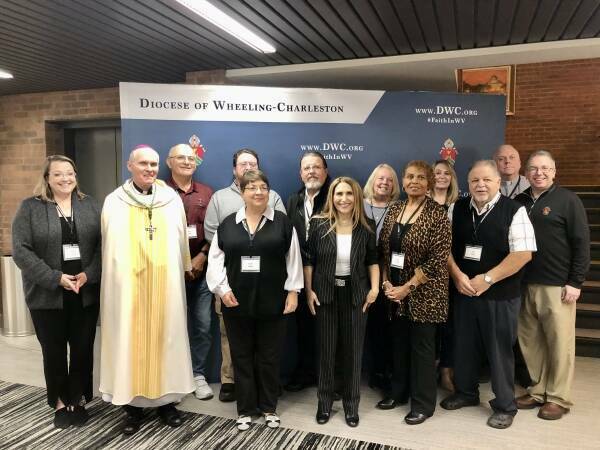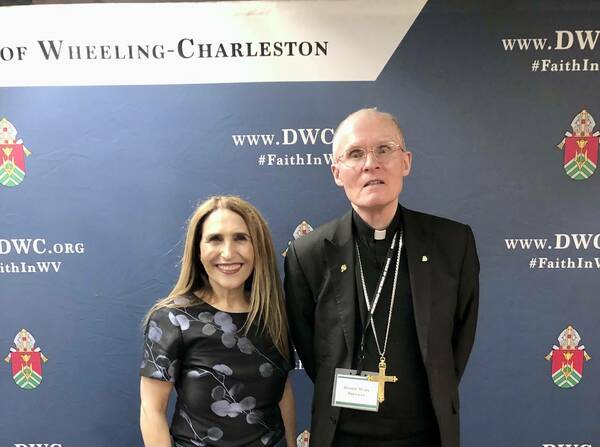When the diocesan council of lay people decided to gather opinions from Catholic parishioners throughout the Diocese of Wheeling-Charleston, West Virginia, they created and sent questionnaires to the 97 parishes and missions across the state.
However, the survey consisted of many multi-faceted questions that turned out to be more complex than expected. Many open-ended questions created confusion about how to “score” the responses, so the diocese turned to the University of Notre Dame for help.

“When we came together to do this in 2021, everyone was really excited,” said Gina Boggess, a bishop’s council member and parishioner of Sacred Heart Catholic Church in Princeton, West Virginia. “We felt like before we could make any recommendations to (Bishop Mark E. Brennan), we wanted to understand what was in the hearts of the people.”
The Catholic Church had opened a synod—a two-year process of listening and dialogue—in October 2021 that will conclude in 2023. The lay leadership in the diocese thought having their own mini-synod would be helpful, said Tim Bishop, director of marketing and communications for the diocese. But when a mountain of information surveys that were difficult to code piled up, the parishioner who volunteered to tackle it realized it was beyond both his ability and time to devote to the project.
Boggess’s brother, Nicholas Preservati, is a 1994 graduate of Notre Dame, so she reached out first to the mathematics department to see if a researcher would be willing to assist.
Her search led to Roya Ghiaseddin, a professor of the practice in the Department of Applied and Computational Mathematics and Statistics, who was excited to tackle the assignment. Some of the questions were straightforward, she said, but many needed some “cleaning,” a term data scientists use when they need to fix, remove, or work with incorrectly formatted, duplicate, or incomplete data.
Ghiaseddin, receiving help from two undergraduate teaching assistants and a graduate student, started reviewing the material in January 2022 and finished combing through and analyzing data by the fall. In October 2022 she traveled to Charleston to present her findings to the Bishop’s Council. Her presentations, which lasted two days for four hours each day, contained about 400 graphs and charts.

“There were responses from about 2,000 people with many open-ended questions,” Ghiaseddin said. “For example, one question was, ‘Please share additional ways you have felt supported by your church. So I had to see how many people said they were supported by their parish, and find out how many people said they felt supported by a priest, or by being at Mass, etc. This means I had to treat each answer option as a new question.
“It took a long time but I wanted to do a correct job without any mistakes,” Ghiaseddin said.
Ghiaseddin, who is not Christian, said she was able to review the questionnaires objectively, using only data analysis to report results. The myriad findings are lengthy and diverse because of the number of parishes and diversity around the state. However, though about 70 percent of the respondents were over age 60, findings that surprised both Ghiaseddin and members of the diocese were that many increasingly accept divorce and want a path to quicker annulments, and many are interested in attending a Latin Mass.
“The other thing we saw was that people wanted more transparency,” said Denise Laurine-Klug, office manager for the Parochial Cluster of Marshal, Wetzel and Tyler counties, who read all the responses before sharing with Ghiaseddin.
She, Boggess, and Bishop praised Ghiaseddin’s work and dedication to the project.
“There were a lot of written essays, and Roya did a really great job of extracting all the information that was in there, and breaking it down,” she said. “Roya has an incredibly analytical mind.”
Bishop Brennan sent a letter in January to Notre Dame President Rev. John I. Jenkins, C.S.C., to express his gratitude for Ghiaseddin’s work.
“I am so happy we could help, and I am grateful to Dr. Ghiaseddin for her generous assistance,” Jenkins wrote back. “It is part of our mission to serve the church, and I am so grateful that Notre Dame could do this through Dr. Ghiaseddin’s expertise.”
Ghiaseddin said she may work with the diocese again, as members contemplate another questionnaire now that Covid shut-downs and pauses have abated. Working with the diocese from the start will create a proper qualitative and quantitative tool, leading to an easier way to read results.
She received her doctorate degree in Quantitative Psychology from Notre Dame in 1995 after receiving a master’s degree in business and another master’s degree in Quantitative Psychology here in 1990. After her graduation she became a faculty member of Mendoza College of Business. She was named a faculty member of College of Science when the ACMS department was created in 2011.
“I’m a triple Domer; once I came to Notre Dame I never left; this is my home,” she said, and thanked Jonathan Hauenstein, chair of the department, for his support of the project. “I am always happy to help.”